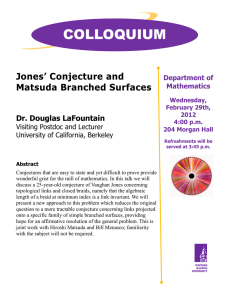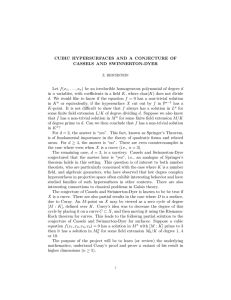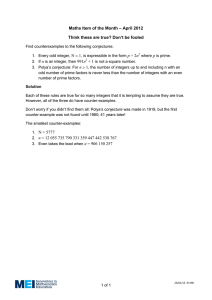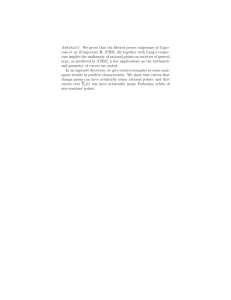Algebraic points on hypersurfaces
advertisement
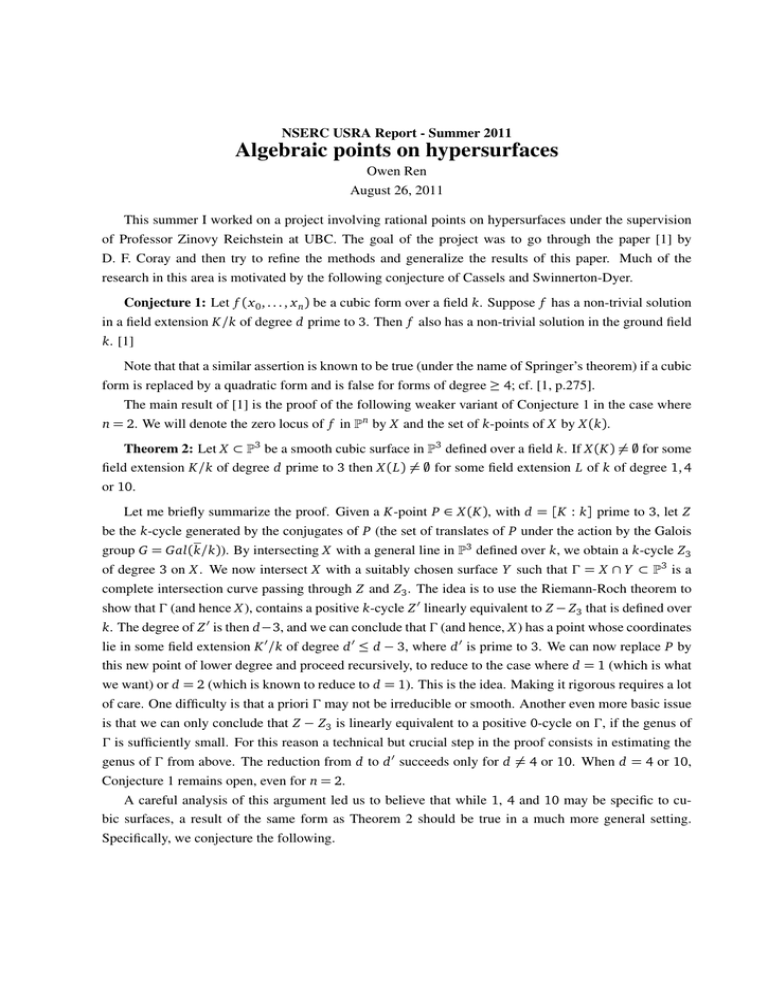
NSERC USRA Report - Summer 2011 Algebraic points on hypersurfaces Owen Ren August 26, 2011 This summer I worked on a project involving rational points on hypersurfaces under the supervision of Professor Zinovy Reichstein at UBC. The goal of the project was to go through the paper [1] by D. F. Coray and then try to refine the methods and generalize the results of this paper. Much of the research in this area is motivated by the following conjecture of Cassels and Swinnerton-Dyer. Conjecture 1: Let f (x 0 , . . . , x n ) be a cubic form over a field k. Suppose f has a non-trivial solution in a field extension K/k of degree d prime to 3. Then f also has a non-trivial solution in the ground field k. [1] Note that that a similar assertion is known to be true (under the name of Springer’s theorem) if a cubic form is replaced by a quadratic form and is false for forms of degree ≥ 4; cf. [1, p.275]. The main result of [1] is the proof of the following weaker variant of Conjecture 1 in the case where n = 2. We will denote the zero locus of f in Pn by X and the set of k-points of X by X (k). Theorem 2: Let X ⊂ P3 be a smooth cubic surface in P3 defined over a field k. If X (K) ̸= ; for some field extension K/k of degree d prime to 3 then X (L) ̸= ; for some field extension L of k of degree 1, 4 or 10. Let me briefly summarize the proof. Given a K -point P ∈ X (K), with d = [K : k] prime to 3, let Z be the k-cycle generated by the conjugates of P (the set of translates of P under the action by the Galois group G = Gal(k/k)). By intersecting X with a general line in P3 defined over k, we obtain a k-cycle Z3 of degree 3 on X . We now intersect X with a suitably chosen surface Y such that Γ = X ∩ Y ⊂ P3 is a complete intersection curve passing through Z and Z3 . The idea is to use the Riemann-Roch theorem to show that Γ (and hence X ), contains a positive k-cycle Z ′ linearly equivalent to Z − Z3 that is defined over k. The degree of Z ′ is then d −3, and we can conclude that Γ (and hence, X ) has a point whose coordinates lie in some field extension K ′ /k of degree d ′ ≤ d − 3, where d ′ is prime to 3. We can now replace P by this new point of lower degree and proceed recursively, to reduce to the case where d = 1 (which is what we want) or d = 2 (which is known to reduce to d = 1). This is the idea. Making it rigorous requires a lot of care. One difficulty is that a priori Γ may not be irreducible or smooth. Another even more basic issue is that we can only conclude that Z − Z3 is linearly equivalent to a positive 0-cycle on Γ, if the genus of Γ is sufficiently small. For this reason a technical but crucial step in the proof consists in estimating the genus of Γ from above. The reduction from d to d ′ succeeds only for d ̸= 4 or 10. When d = 4 or 10, Conjecture 1 remains open, even for n = 2. A careful analysis of this argument led us to believe that while 1, 4 and 10 may be specific to cubic surfaces, a result of the same form as Theorem 2 should be true in a much more general setting. Specifically, we conjecture the following. Conjecture 3: Let k be a field and n, s ≥ 1 be integers. Then there exists an integer do (n, s) with the following property: For every hypersurface X ⊂ Pn−1 of degree s with a point P in some extension K of k k of degree prime to s, there is an extension L of k such that (i) [L : k] is prime to s, (ii) X (L) ̸= ;, and (iii) [L : k] ≤ do (n, s). For cubics (with s = 3) this is a bit weaker than Conjecture 1, which asserts that, d0 (n, 3) can be taken to be 1. (Theorem 2 tells us that d0 (4, 3) can be taken to be 10.) On the other hand, Conjecture 3 has two advantages over these results: it is more general (because s is allowed to be arbitrary) and it appears to be more accessible. Our goal now is to modify Coray’s argument to prove this conjecture. Given a point in X (K) we define Z and Z3 as before and create a complete intersection curve Γ on X , passing through Z and Z3 . Once again, the main technical challenge is to estimate the genus of this curve from above. Our work on this conjecture is ongoing. References [1] Coray D.R., Algebraic points on cubic hypersurfaces, ACTA ARITHMETICA XXX, 1976.


